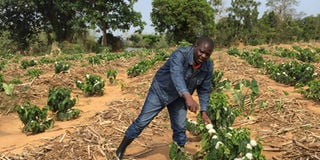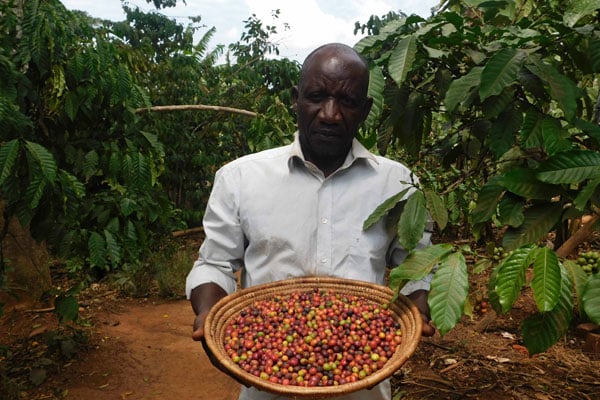Prime
Pick more beans from 3mx1m spacing

Joseph Nkandu inspects his Robusta coffee crop planted at the 3x1 spacing soon after his return from Brazil. Photo | Michael J Ssali
What you need to know:
- The study shows that while coffee farmers are likely to realize higher yields using a spacing method of 3mx1m compared to the traditional 3mx3m, farmers who go for the 3mx1m spacing method must invest more to reap the benefits.
While the 3mx1m spacing method gives higher yields, close spacing creates a lot of competition among Robusta coffee trees which compromises on their robustness attributes, a new study says.
Spacing
The study shows that while coffee farmers are likely to realize higher yields using a spacing method of 3mx1m compared to the traditional 3mx3m, farmers who go for the 3mx1m spacing method must invest more to reap the benefits.
The findings are from on-farm trials by Ugandan scientists at National Coffee Research Institute (NaCORI) and National Agricultural Research Organisation (Naro).
The results also show that there was high incidences of pests and diseases under closely spaced fields compared to widely spaced fields. The researchers say more studies need to be conducted before the 3mx1m spacing regime is recommended to farmers.
Why Brazil’s 3mx1m
According to the findings of the study published in the Australian Journal of Crop Science, the study aimed to compare on-farm performance of Robusta coffee under two contrasting spacing regimes of Uganda’s 3mx3m and Brazil’s 3mx1m. The study compared the pest incidence and damage, disease incidence and severity, growth response and yield potential under the two contrasting spacing regimes.
The research was led by Godfrey Sseremba and assisted by Godfrey Hubby Kagezi, Judith Kobusinge, Pascal Musoli, David Akodi, Nicholas Olango, Patrick Kucel, Job Chemutai, Joseph Mulindwa and Geoffrey Arinaitwe.
The study was imposed in July 2017 on already established farmer’s Robusta coffee fields at Bunjakko Island, Buwama sub-county in Mpigi District.
Two spacing regimes
The researchers used clonal cuttings of coffee wilt disease resistant (CWD-r) Robusta coffee varieties. The planting materials, a composite of seven CWD-r varieties were obtained from NaCORI. It is important to note that under 3mx1m spacing, an acre will accommodate about 1,330 plants of coffee while under the traditional 3mx3m spacing, an acre will accommodate only 450 plants.
Importantly, plant density in Robusta coffee is an unresolved issue in low volume producing countries especially when compared with leading producers.
Therefore, NaCORI with funding from Uganda Coffee Development Authority (UCDA) thought to study the two spacing regimes so that the information generated can be used by researchers, policy makers and extension workers when recommending to farmers the best-bet spacing of coffee for maximum productivity.
Growth response and yield
The study reveals that there was a significant difference in growth response between spacing regimes for canopy height (dCAH), number of primaries (dNOP), number of stems (aNOS), leaf blade length (aLBL) and leaf blade width (aLBW).
“The dCAH was higher under 3mx1m spacing than for 3mx3m spacing. Specifically, dCAH for closely coffee fields was higher by 7.91 cm and 11.84 cm when compared to widely spaced fields 2 and 3, respectively. The dNOP for 3mx1m and 3mx3m spacing was 0 and 5, respectively. The aNOS was lower for close spacing at 2 stems/tree than wide spacing at 3 stems/tree,” the study results indicate.
Further, the study reveals, longer leaves (24.4 cm) were obtained under wide spacing as compared to close spacing (23.6 cm).
Conversely, wider leaves were obtained under close spacing (10.4 cm) compared to wide spacing (9.9 cm).
According to the study, “It is suggested that close spacing creates a lot of competition among Robusta coffee trees which compromises on their robustness attributes (Sakai et al., 2013; Salamanca-Jimenez).”
Green bean yield potential
The study also shows that there was a significant difference in yield potential between spacing regimes for average yield per tree (aYT) and average yield per hectare (aYH).
“Specifically, aYH was higher under close spacing (3mx1m) at 5.82 t cc/ha than wide spacing at 4.80 t cc/ha (3mx3m). The aYT was however, higher under wide spacing at 2.31 kg cc/tree than close spacing which generated 1.75 kg cc/tree. Similarly, higher number of berries per tree was observed under wide spacing at 6,934 berries per tree than close spacing which produced 5,241 berries per tree,” the study says.
The observation by researchers suggests that as plant density increases, yield increases as earlier suggested by AnimKwapong et al. (2010) and Paulo et al. (2010).
Pest incidence
According to the study, pest incidence varied with spacing with some pests exhibiting a higher incidence under close spacing (3mx1m) than wide spacing (3mx3m), and vice-versa.
There was a significant association between RMB (root mealybugs) infestation and spacing.
“Widely spaced coffee fields were recorded with a higher RMB incidence than the closely spaced field. Further, there was a significant interaction between moth and spacing for incidence of LM (leaf miners) but non-significant for BCTB (black coffee twig borers), SKL (leaf skeletonizers), TC (tailed caterpillars), LEB (leaf eating beetles), CM (canopy mealybugs), Scales, BM (berry moths) and CBB (berry borer),” the study says.
It adds that there was also a significant difference in incidence of pests between months for BCTB and CBB.
It further says there was a highly significant difference in pest incidence between the spacing regimes for all the pests except scales.
Explaining their findings, the researchers say high RMB presence was associated with 3mx3m compared to 3mx1m most likely because the 3mx1m plantation was younger than 3mx3m fields.
“RMBs are more incident when plants are stressed. The 3mx3m fields consisting old plants are most probably more stressed than recently established plantations,” it says.
According to the study, “subject to further investigation, close spacing could be a remedy for LM, SKL, TC, BM and CBB whose incidence was lower under wide spacing than with close spacing.”
Disease incidence and severity
According to the study, “The incidences for RBD (Red Blister Disease) was lower under closely spaced coffee than with widely spaced (3mx3m) coffee fields. The difference in RBD between spacing regimes was very highly significant. There was a lower RBD severity (1.0; no symptoms) under close spacing (3mx1m) compared to widely spaced (3mx3m) coffee whose mean severity was 1.6.”
The study says absence of symptoms for some diseases under close spacing is attributable to absence of source of inoculums as the plantation was relatively young.
Conclusion
In conclusion, researchers say plant density has a significant effect on pest incidence, disease incidence and severity, growth response and yield of Robusta coffee. The plant density effect also has temporal dimensions.
“As plant stress increases under close spacing, pest problems such as RMB and BCTB also increase. Similarly, high yield potential per tree triggers plant stress due to increase in soil, water and nutrient harvesting, resulting in disease challenges especially RBD. The growth robustness in Robusta coffee cannot be fully expressed under close spacing though this notion requires further optimization,” researchers say in the study.




